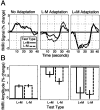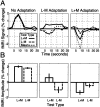Selective adaptation to color contrast in human primary visual cortex
- PMID: 11356883
- PMCID: PMC6762682
- DOI: 10.1523/JNEUROSCI.21-11-03949.2001
Selective adaptation to color contrast in human primary visual cortex
Abstract
How neural activity produces our experience of color is controversial, because key behavioral results remain at odds with existing physiological data. One important, unexplained property of perception is selective adaptation to color contrast. Prolonged viewing of colored patterns reduces the perceived intensity of similarly colored patterns but leaves other patterns relatively unaffected. We measured the neural basis of this effect using functional magnetic resonance imaging. Subjects viewed low-contrast test gratings that were either red-green (equal and opposite long- and middle-wavelength cone contrast, L-M) or light-dark (equal, same-sign, long- and middle-wavelength cone contrast, L+M). The two types of test gratings generated approximately equal amounts of neural activity in primary visual cortex (V1) before adaptation. After exposure to high-contrast L-M stimuli, the L-M test grating generated less activity in V1 than the L+M grating. Similarly, after adaptation to a high-contrast L+M grating, the L+M test grating generated less activity than the L-M test grating. Behavioral measures of adaptation using the same stimuli showed a similar pattern of results. Our data suggest that primary visual cortex contains large populations of color-selective neurons that can independently adjust their responsiveness after adaptation. The activity of these neural populations showed effects of adaptation that closely matched perceptual experience.
Figures




Similar articles
-
The selectivity of responses to red-green colour and achromatic contrast in the human visual cortex: an fMRI adaptation study.Eur J Neurosci. 2015 Dec;42(11):2923-33. doi: 10.1111/ejn.13090. Epub 2015 Nov 5. Eur J Neurosci. 2015. PMID: 26414774 Free PMC article.
-
Adaptation of oriented and unoriented color-selective neurons in human visual areas.Neuron. 2005 Feb 17;45(4):613-23. doi: 10.1016/j.neuron.2005.01.014. Neuron. 2005. PMID: 15721246
-
Specializations for chromatic and temporal signals in human visual cortex.J Neurosci. 2005 Mar 30;25(13):3459-68. doi: 10.1523/JNEUROSCI.4206-04.2005. J Neurosci. 2005. PMID: 15800201 Free PMC article.
-
Neural mechanisms for color perception in the primary visual cortex.Curr Opin Neurobiol. 2002 Aug;12(4):426-32. doi: 10.1016/s0959-4388(02)00349-5. Curr Opin Neurobiol. 2002. PMID: 12139991 Review.
-
Color in the cortex: single- and double-opponent cells.Vision Res. 2011 Apr 13;51(7):701-17. doi: 10.1016/j.visres.2011.02.012. Epub 2011 Feb 17. Vision Res. 2011. PMID: 21333672 Free PMC article. Review.
Cited by
-
The effect of background and illumination on color identification of real, 3D objects.Front Psychol. 2013 Nov 11;4:821. doi: 10.3389/fpsyg.2013.00821. eCollection 2013. Front Psychol. 2013. PMID: 24273521 Free PMC article.
-
Color perception in children with autism.J Autism Dev Disord. 2008 Nov;38(10):1837-47. doi: 10.1007/s10803-008-0574-6. Epub 2008 May 1. J Autism Dev Disord. 2008. PMID: 18449634
-
The time course of chromatic adaptation in human early visual cortex revealed by SSVEPs.J Vis. 2023 May 2;23(5):17. doi: 10.1167/jov.23.5.17. J Vis. 2023. PMID: 37223943 Free PMC article.
-
The selectivity of responses to red-green colour and achromatic contrast in the human visual cortex: an fMRI adaptation study.Eur J Neurosci. 2015 Dec;42(11):2923-33. doi: 10.1111/ejn.13090. Epub 2015 Nov 5. Eur J Neurosci. 2015. PMID: 26414774 Free PMC article.
-
fMRI adaptation reveals mirror neurons in human inferior parietal cortex.Curr Biol. 2008 Oct 28;18(20):1576-80. doi: 10.1016/j.cub.2008.08.068. Curr Biol. 2008. PMID: 18948009 Free PMC article.
References
-
- Atick JJ, Li Z, Redlich N. What does post-adaptation color appearance reveal about cortical color representation? Vision Res. 1993;33:123–129. - PubMed
-
- Boynton GM, Demb JB, Glover GH, Heeger DJ. Neural basis of contrast discrimination. Vision Res. 1998;38:1555–1560. - PubMed
-
- Bradley A, Switkes E, De Valois K. Orientation and spatial frequency selectivity of adaptation to color and luminance gratings. Vision Res. 1988;28:841–856. - PubMed
Publication types
MeSH terms
Grants and funding
LinkOut - more resources
Full Text Sources
